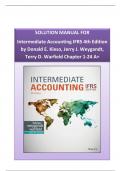Exam (elaborations)
SOLUTION MANUAL FOR Intermediate Accounting IFRS 4th Edition by Donald E. Kieso, Jerry J. Weygandt, Terry D. Warfield Chapter 1-24 A+
- Course
- Institution
- Book
SOLUTION MANUAL FOR Intermediate Accounting IFRS 4th Edition by Donald E. Kieso, Jerry J. Weygandt, Terry D. Warfield Chapter 1-24 A+
[Show more]



